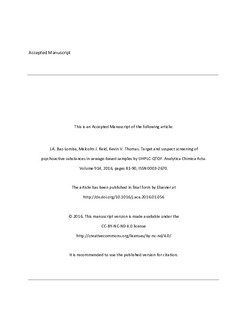| dc.contributor.author | Baz Lomba, Jose Antonio | |
| dc.contributor.author | Reid, Malcolm J | |
| dc.contributor.author | Thomas, Kevin V | |
| dc.date.accessioned | 2018-11-02T08:16:21Z | |
| dc.date.available | 2018-11-02T08:16:21Z | |
| dc.date.issued | 2016 | |
| dc.identifier.citation | Analytica Chimica Acta. 2016. 914, 81-90. | nb_NO |
| dc.identifier.issn | 0003-2670 | |
| dc.identifier.uri | http://hdl.handle.net/11250/2570714 | |
| dc.description.abstract | The quantification of illicit drug and pharmaceutical residues in sewage has been shown to be a valuable tool that complements existing approaches in monitoring the patterns and trends of drug use. The present work delineates the development of a novel analytical tool and dynamic workflow for the analysis of a wide range of substances in sewage-based samples. The validated method can simultaneously quantify 51 target psychoactive substances and pharmaceuticals in sewage-based samples using an off-line automated solid phase extraction (SPE-DEX) method, using Oasis HLB disks, followed by ultra-high performance liquid chromatography coupled to quadrupole time-of-flight mass spectrometry (UHPLC-QTOF) in MSe. Quantification and matrix effect corrections were overcome with the use of 25 isotopic labeled internal standards (ILIS). Recoveries were generally greater than 60% and the limits of quantification were in the low nanogram-per-liter range (0.4–187 ng L−1). The emergence of new psychoactive substances (NPS) on the drug scene poses a specific analytical challenge since their market is highly dynamic with new compounds continuously entering the market. Suspect screening using high-resolution mass spectrometry (HRMS) simultaneously allowed the unequivocal identification of NPS based on a mass accuracy criteria of 5 ppm (of the molecular ion and at least two fragments) and retention time (2.5% tolerance) using the UNIFI screening platform. Applying MSe data against a suspect screening database of over 1000 drugs and metabolites, this method becomes a broad and reliable tool to detect and confirm NPS occurrence. This was demonstrated through the HRMS analysis of three different sewage-based sample types; influent wastewater, passive sampler extracts and pooled urine samples resulting in the concurrent quantification of known psychoactive substances and the identification of NPS and pharmaceuticals. | nb_NO |
| dc.language.iso | eng | nb_NO |
| dc.publisher | Elsevier | nb_NO |
| dc.rights | Attribution-NonCommercial-NoDerivatives 4.0 Internasjonal | * |
| dc.rights.uri | http://creativecommons.org/licenses/by-nc-nd/4.0/deed.no | * |
| dc.title | Target and suspect screening of psychoactive substances in sewage-based samples by UHPLC-QTOF | nb_NO |
| dc.type | Journal article | nb_NO |
| dc.type | Peer reviewed | nb_NO |
| dc.description.version | acceptedVersion | nb_NO |
| dc.source.pagenumber | 81-90 | nb_NO |
| dc.source.volume | 914 | nb_NO |
| dc.source.journal | Analytica Chimica Acta | nb_NO |
| dc.identifier.doi | 10.1016/j.aca.2016.01.056 | |
| dc.identifier.cristin | 1366592 | |
| dc.relation.project | EC/FP7/317205 | nb_NO |

